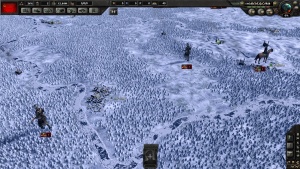Weather
This article is considered accurate for the current version of the game.

We were not happy with the weather-system in HoI3. It was a complex simulation that tried to work as close to reality as possible. It was basically impossible to tweak to the situations we wanted (like very hot desert areas or cold winter in Russia in ’41), and players disliked it. It was a small performance hog and last but not least - all that effort was tucked away in a mapmode you had to keep checking (so most people did not). So for this iteration of the series, we decided to take an entirely different approach.
There is no forecasting. The best forecast is still to guess same weather as its today for tomorrow. Consider weather unpredictable and your enemy.
Contents
Full scripting control[edit]
Probability for each type of weather can now be scripted for each strategic region for each month, or a definable period. So for example we can get that hardcore, dirty, Russian mud everyone is craving for the months and locations where it makes sense. For modders out there we made a really nifty tool for setting up these values so its easy to tweak and work with (so when you guys make the Cats of the 4th Reich total conversion I’v been waiting for it will be easy). This means that since we can set everything ourselves we have full control over the gameplay effects we want rather than relying on a complex simulation to get it right.
Types[edit]
There are 6 types of basic weather in the game. These directly affect air and navies and land units indirectly (we get to that)
Clear skies[edit]
- Baseline weather with no modifiers. Just enjoy the sun bro :)
Rain[edit]
- Harder to detect enemy air and navies.
- Airplane attacks against ships less effective as well as ship-to-ship accuracy.
- Higher risk of airplane accidents.
Storm[edit]
- A much stronger version of Light Rain.
- Carrier planes won't be able to take off.
- Bombers will have a hard time hitting targets.
Snow[edit]
- Harder to detect enemy air and navies.
- Airplane attacks against ships less effective as well as ship-to-ship accuracy.
- Higher risk of airplane accidents.
Blizzard[edit]
- A much stronger version of Snow.
- Carrier planes won't be able to take off.
- Bombers will have a hard time hitting targets.
Sandstorm[edit]
- Almost impossible to detect other aircraft.
- Extremely high chance of airplane accidents.
- Bombers won’t be able to hit targets on ground.
Temperature[edit]
Temperature is tracked on province level and mainly affects attrition levels. If its very cold or very warm things will tend to break down a lot more often. You’ll want leaders with the Winter Specialist trait to maximize your efficiency in cold weather.
Dig-in speed is slowed down a lot in extreme cold.
There is no winter clothing research as such. Thats basically common sense and player would always use perfect hindsight and not fight in winter unprepared. We are evil, so you'll need to actually gain those winter specialist traits through fighting in cold weather. No shortcuts.
Mud and Snow[edit]
(So, ok, there is a bit of simulation.) When it rains or snows we keep track of that (so we can show it on the map) but also to keep track of if it has gotten to extreme levels. Very high snow will affect unit movement speed, but Mud is going to increase attrition levels a lot as well as slow you down to a crawl. A smart player will try not to attack (as a wild example) The Soviet Union just as mud season begins or they might find a lot of their panzer divisions bogged down.
If the area is set up as susceptible to mud that time of year and water levels over a time period is high enough mud develops. either rain or melting snow. doesnt matter if anyone has traveled over it (remember not a super complicated simulation we'll never be able to balance)
Shown on map[edit]
Since weather has such a large impact we wanted to make sure it was always visible to the player. Snow/mud and such is shown directly on the map while storm clouds and rain is in a layer above which we fade away the closer you get so as not to obscure unit movements.


